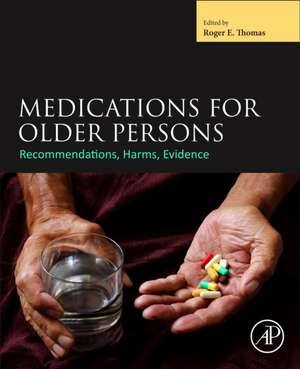Medications for Older Persons: Recommendations, Harms, Evidence
Editat de Roger Thomasen Limba Engleză Paperback – aug 2025
The remainder of the book is devoted to the assessment of medication groups focusing on Numbers Needed to Treat, Numbers Needed to Harm, and characteristics and numbers of adverse events. Medication groups covered include cardiovascular, central nervous system, renal, gastrointestinal, musculoskeletal, respiratory, endocrine, pain, and fall prevention.
- Conveys the benefit and harm profiles of medications for older persons
- Outlines which randomized controlled trials (RCTs) of medication effects have the lowest risk of bias and highest GRADE quality
- Discusses which randomized, controlled trials (RCTs) have the longest and most complete follow up and accounts for the key risk factors and confounders
Preț: 779.81 lei
Preț vechi: 856.94 lei
-9% Nou
Puncte Express: 1170
Preț estimativ în valută:
149.24€ • 154.17$ • 124.20£
149.24€ • 154.17$ • 124.20£
Carte nepublicată încă
Doresc să fiu notificat când acest titlu va fi disponibil:
Se trimite...
Preluare comenzi: 021 569.72.76
Specificații
ISBN-13: 9780443290251
ISBN-10: 0443290253
Pagini: 300
Dimensiuni: 191 x 235 mm
Editura: ELSEVIER SCIENCE
ISBN-10: 0443290253
Pagini: 300
Dimensiuni: 191 x 235 mm
Editura: ELSEVIER SCIENCE
Cuprins
Section 1. Recommendations for medications of older persons
1. A summary of medications that most benefit older patients: for clinicians, patients, their families, policy makers and health ministries
2. STOPP and American Geriatrics Society “potentially inappropriate medications" (PIMs) and START ”potential prescribing omissions” (PPOs)
3. The Calgary study of 295,706 admissions of older persons to four acute care hospitals 2013-2021
4. Adverse drug interactions in the Veterans Affairs Adverse Drug Event Reporting System
5. Pharmacokinetics and pharmacodynamics in older persons
6. Methods to identify adverse drug interactions and effects
7. How personalized medicine has changed senior patient outcomes at the Mayo Clinic and other centers
Section 2. Older persons alcohol consumption, self-medication, and medication list accuracy
8. Older persons alcohol consumption
9. Self-medication and over the counter medications by older persons
10. The accuracy of recording medication lists, transferring lists between community practitioners and medical institutions, and the potential effects on the accuracy of assessing PIMs, PPOs and adverse medication events
Section 3. Cardiovascular medications
11. Medications for hypertension
12. Medications for heart failure
13. Medications for arrhythmias
14. Medications for diuresis
15. Medications for coagulation
Section 4. Central Nervous System medications
16. Medications for depression
17. Medications for anxiety
18. Medications for insomnia
19. Neuroleptic/antipsychotic medications
20. Avoiding medications with risks of delirium
21. Avoiding medications that augment dementia
Section 5. Renal medication
22. Prescribing to reduce risks of renal insufficiency and failure
Section 6. Gastrointestinal medications
23. Prescribing to reduce the risks of peptic ulcer disease, gastritis, and esophagitis and treat if present
24. Prescribing to reduce the risks of constipation or diarrhea
Section 7. Musculoskeletal medications
25. Medications for arthritis
26. Medications for osteoporosis
Section 8. Respiratory medications
27. Medications for COPD
Section 9. Endocrine medications
28. Medications for diabetes
Section 10. Pain medications
29. Non-opioid analgesics and opioids for seniors
Section 11. Changing prescribing to prevent falls
30. Prescribing to prevent falls
1. A summary of medications that most benefit older patients: for clinicians, patients, their families, policy makers and health ministries
2. STOPP and American Geriatrics Society “potentially inappropriate medications" (PIMs) and START ”potential prescribing omissions” (PPOs)
3. The Calgary study of 295,706 admissions of older persons to four acute care hospitals 2013-2021
4. Adverse drug interactions in the Veterans Affairs Adverse Drug Event Reporting System
5. Pharmacokinetics and pharmacodynamics in older persons
6. Methods to identify adverse drug interactions and effects
7. How personalized medicine has changed senior patient outcomes at the Mayo Clinic and other centers
Section 2. Older persons alcohol consumption, self-medication, and medication list accuracy
8. Older persons alcohol consumption
9. Self-medication and over the counter medications by older persons
10. The accuracy of recording medication lists, transferring lists between community practitioners and medical institutions, and the potential effects on the accuracy of assessing PIMs, PPOs and adverse medication events
Section 3. Cardiovascular medications
11. Medications for hypertension
12. Medications for heart failure
13. Medications for arrhythmias
14. Medications for diuresis
15. Medications for coagulation
Section 4. Central Nervous System medications
16. Medications for depression
17. Medications for anxiety
18. Medications for insomnia
19. Neuroleptic/antipsychotic medications
20. Avoiding medications with risks of delirium
21. Avoiding medications that augment dementia
Section 5. Renal medication
22. Prescribing to reduce risks of renal insufficiency and failure
Section 6. Gastrointestinal medications
23. Prescribing to reduce the risks of peptic ulcer disease, gastritis, and esophagitis and treat if present
24. Prescribing to reduce the risks of constipation or diarrhea
Section 7. Musculoskeletal medications
25. Medications for arthritis
26. Medications for osteoporosis
Section 8. Respiratory medications
27. Medications for COPD
Section 9. Endocrine medications
28. Medications for diabetes
Section 10. Pain medications
29. Non-opioid analgesics and opioids for seniors
Section 11. Changing prescribing to prevent falls
30. Prescribing to prevent falls
